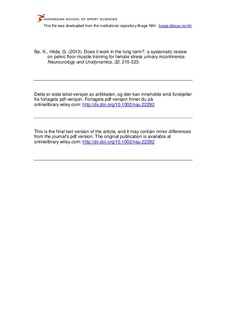| dc.contributor.author | Bø, Kari | |
| dc.contributor.author | Hilde, Gunvor | |
| dc.date.accessioned | 2013-11-04T12:30:32Z | |
| dc.date.available | 2013-11-04T12:30:32Z | |
| dc.date.issued | 2012-07-27 | |
| dc.identifier | Seksjon for idrettsmedisinske fag / Department of Sports Medicine | |
| dc.identifier.citation | Neurourology and Urodynamics. 2013, 32, 215-223 | no_NO |
| dc.identifier.uri | http://hdl.handle.net/11250/171026 | |
| dc.description | Dette er siste tekst-versjon av artikkelen, og den kan inneholde små forskjeller fra forlagets pdf-versjon. Forlagets pdf-versjon finner du på onlinelibrary.wiley.com: http://dx.doi.org/10.1002/nau.22292 / This is the final text version of the article, and it may contain minor differences from the journal's pdf version. The original publication is available at onlinelibrary.wiley.com: http://dx.doi.org/10.1002/nau.22292 | no_NO |
| dc.description.abstract | There is level 1, grade A evidence that pelvic floor muscle training (PFMT) is effective in treatment of stress urinary incontinence (SUI), but long-term outcome has been questioned. The aim of this systematic review was to evaluate the long-term outcome of PFMT for female SUI.
Conclusions: Short-term outcome of PFMT can be maintained at long-term follow-up without incentives for continued training, but there is a high heterogeneity in both interventional and methodological quality in short-and long-term pelvic floor muscle training studies. | no_NO |
| dc.language.iso | eng | no_NO |
| dc.publisher | John Wiley & Sons | no_NO |
| dc.subject | exercise | no_NO |
| dc.subject | follow-up | no_NO |
| dc.subject | pelvic floor | no_NO |
| dc.subject | urinary incontinence | no_NO |
| dc.title | Does it work in the long term?: A systematic review on pelvic floor muscle training for female stress urinary incontinence | no_NO |
| dc.type | Journal article | no_NO |
| dc.type | Peer reviewed | no_NO |
| dc.subject.nsi | VDP::Medical disciplines: 700 | no_NO |
| dc.source.journal | Neurourology and Urodynamics | no_NO |
| dc.identifier.doi | 10.1002/nau.22292 | |
